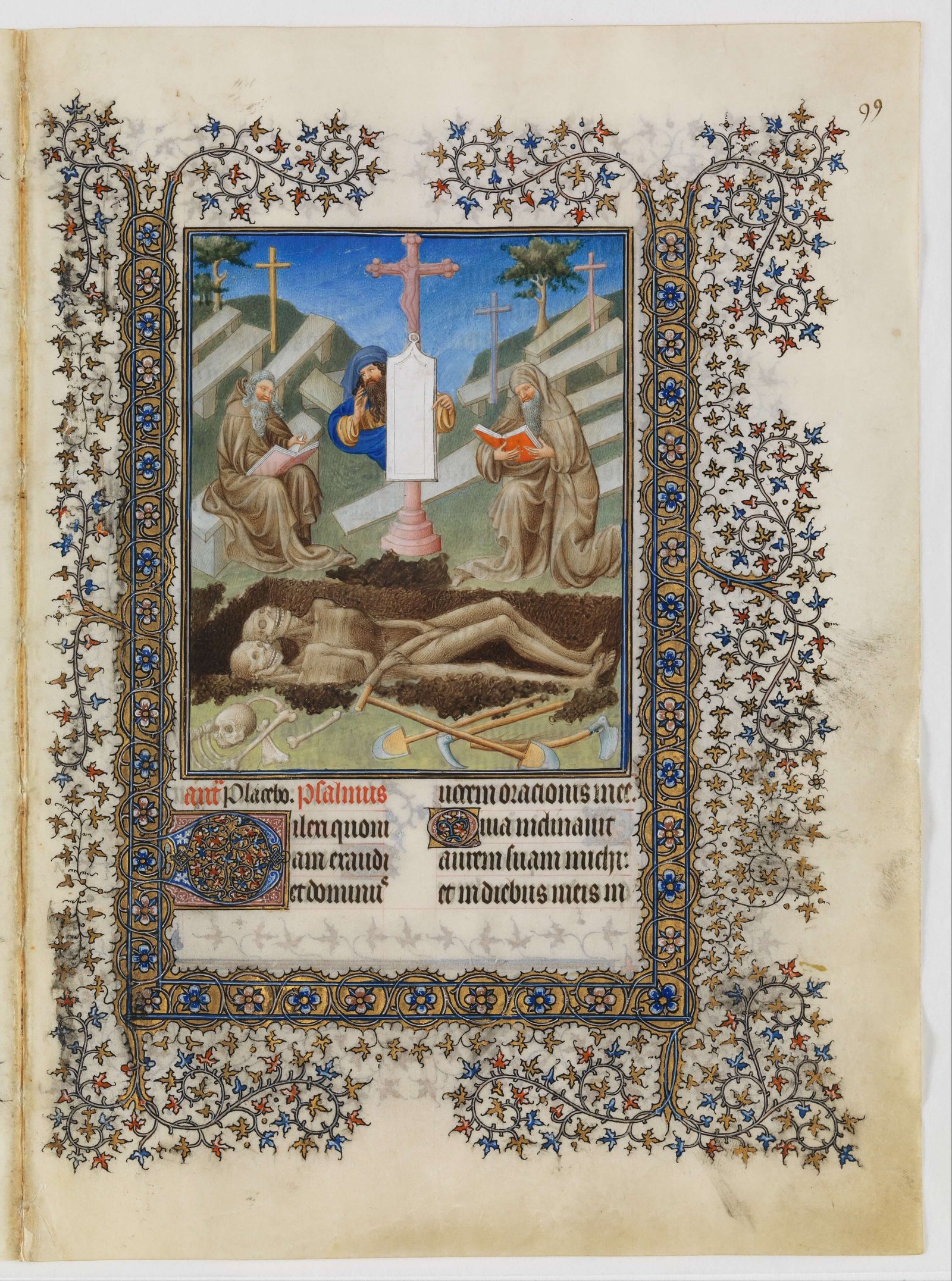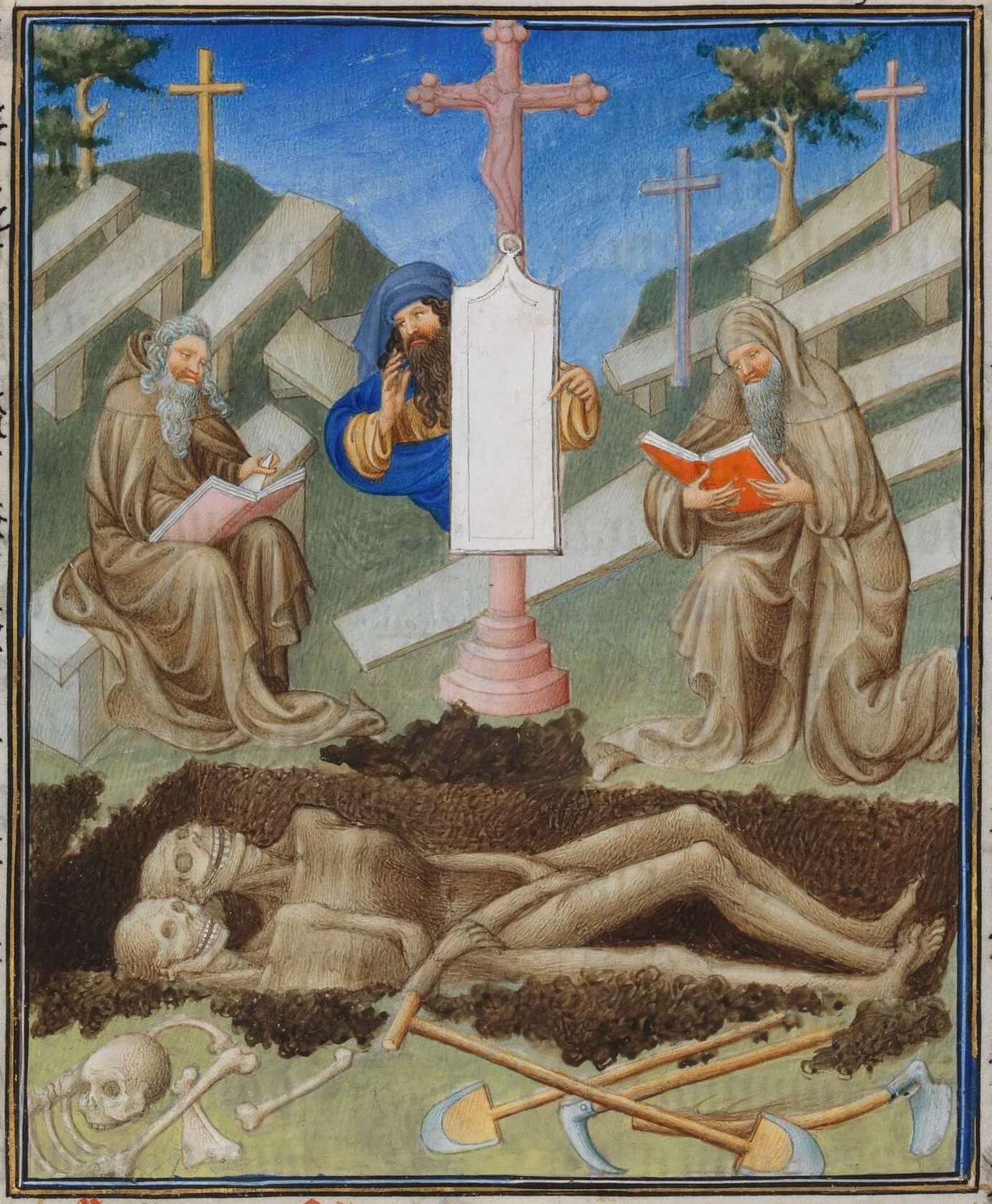Welcome to 31 Days of Medieval Manuscripts, a month-long series introducing the fascinating and brilliant world of medieval illuminated manuscripts.

The Office of the Dead (f.99) from the Belles Heures of Jean de Berry. French, c. 1405-9. The Cloisters Collection. Metropolitan Museum of Art, New York. (CC0 1.0)
This is the last installment of 31 Days of Medieval Manuscripts. I hope everyone has enjoyed seeing and reading about all these beautiful books over the past month!
Today’s post topic was one I planned well in advance because of its appropriateness for Halloween as well as my general interest in the topic. It brings us back to the Book of Hours, which we first met on day two of this series. In that post, I told you that books of hours include more material than just prayers for the canonical hours of the day. We’ve discussed one example of this material already – calendar pages. Today’s feature is another example, the Office of the Dead.
The Office of the Dead is a selection of prayers to be performed for the benefit of deceased souls in aid their passage into Heaven. What’s really cool about it for our purposes as art historians is that this subject matter is frequently accompanied by some morbid and fascinating illustrations. The tamer and more obvious images depict graveyards, funerals, and funeral Masses, but the creepier ones involve things like re-animated skeletons and corpses (medieval zombies, perhaps). Some of them related to known medieval legends, usually with overt moralizing messages. A popular and easy-to-recognize example is the Three Living and the Three Dead, in which three noblemen or kings encounter three walking corpses, who remind them about the transience of life. Not all of the illustrations, however, are nearly so simply to interpret.
I first became interested in this topic when I encountered the particularly-perplexing Office of the Dead illustration in the Belles Heures of Jean de Berry. In fact, I wrote a whole paper trying to interpret it it in college. This image (shown at the top of this post) depicts two grinning corpses within the same plain, uncovered grave. A trio of men appear behind them, but two ignore the corpses in favor of reading books and only one looks on while holding his hand to his face in a gesture than might imply either shock or speech. This third man seems to float behind a standing cross and points to a large, empty plaque attached to it, though he could also be pointing to the bodies. The scene seems to take place in a graveyard of sorts, except the graves look more like benches and one of the reader figures actually sits on one of these benches. A set of detached human bones and group of tools rest in the scene’s extreme foreground.
Needless to say, this is a very bizarre image, and I still have no idea what’s going on here. Why are there two corpses in the same grave? Why do they lack shrouds, coffins, or any of the other trappings we would expect to see in a funeral scene? Are they being buried, or are they being dug up? Who are the living men in the image, and what are they doing? What is the significance of the empty plaque? It’s obvious to assume that this is some kind of funeral scene and the men are clergy officiating, but the more you think about it, the less the details actually point to this. For one thing, these bodies have clearly been dead a while. As best as I could determine, there were no common medieval myths or legends this scene could reasonable be said to illustrate. Except for the skeleton in an open grave bit, which does appear elsewhere, the stranger aspects of this image’s iconography do not appear in other Office of the Dead illustrations.
In my original college paper, I determined that the scene should be read allegorically or symbolically rather than as depicting an identifiable event or legend. I don’t necessarily feel super convinced by my interpretations anymore (I was an inexperienced undergraduate at the time), but I still agree with that statement.


Those interested in the Belles Heures (the featured image in this post and the manuscript I discussed in most detail) should try the Metropolitan Museum of Art’s 2008 exhibition catalog The Art of Illumination: The Limbourg Brothers and the Belles Heures of Jean de France, Duc de Berry by Timothy Bates Husband with an essay by Margaret Lawson. It illustrates and discusses every major illustration page in the entire manuscript and is currently available to download or read online for free on the Met’s website.
If you enjoyed this post, you may also enjoy my article about creepy medieval manuscripts for HeadStuff.


